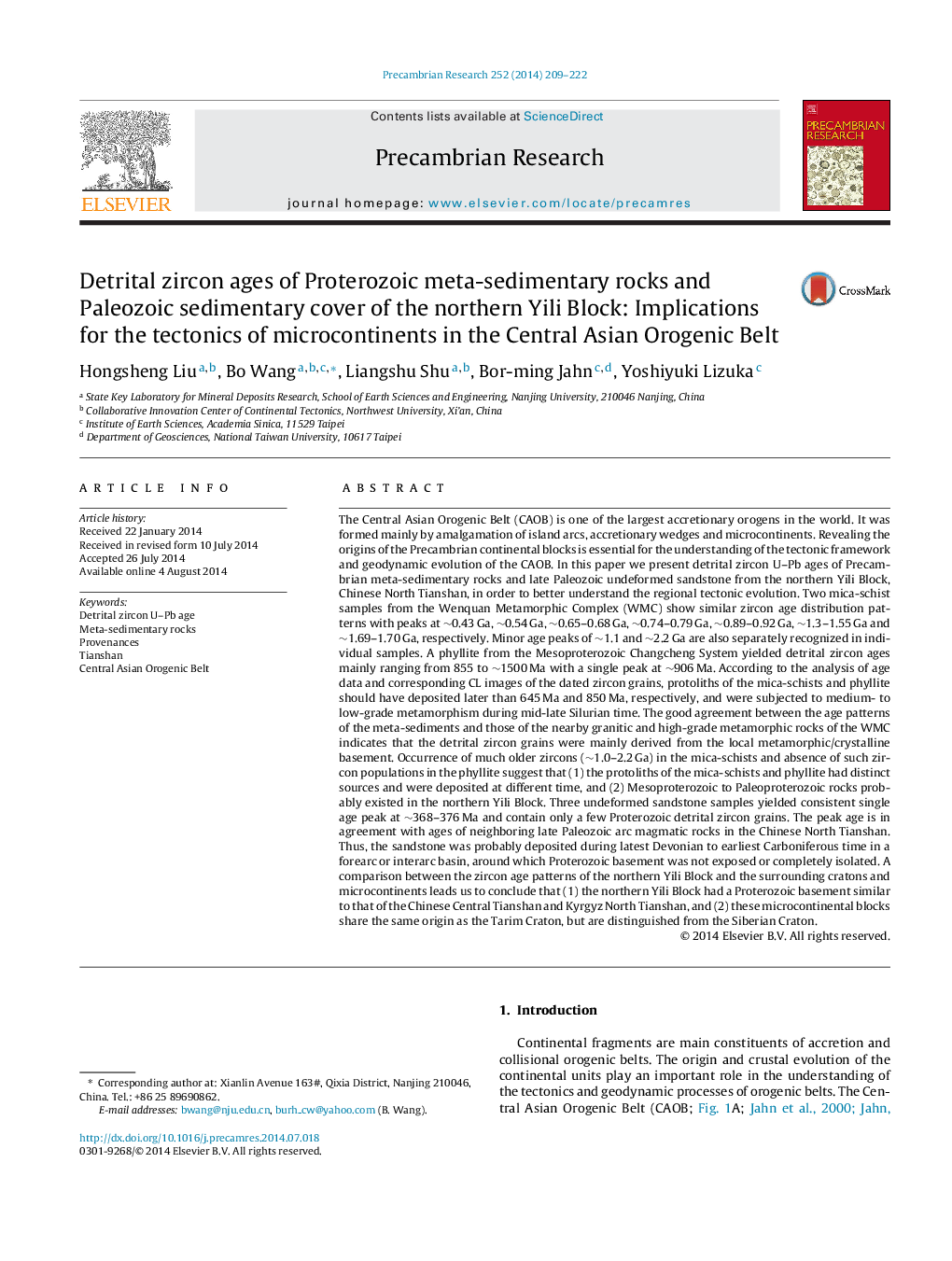| کد مقاله | کد نشریه | سال انتشار | مقاله انگلیسی | نسخه تمام متن |
|---|---|---|---|---|
| 4722955 | 1639622 | 2014 | 14 صفحه PDF | دانلود رایگان |
• Protoliths of the meta-sedimentary rocks were likely deposited during ∼650–430 Ma.
• Neoproterozoic magmatic rocks are dominant provenances of the meta-sediments.
• Meso- to Paleoproterozoic basement probably exists in the northern Yili Block.
• Yili and its neighboring Precambrian blocks in SW CAOB have an origin from Tarim.
The Central Asian Orogenic Belt (CAOB) is one of the largest accretionary orogens in the world. It was formed mainly by amalgamation of island arcs, accretionary wedges and microcontinents. Revealing the origins of the Precambrian continental blocks is essential for the understanding of the tectonic framework and geodynamic evolution of the CAOB. In this paper we present detrital zircon U–Pb ages of Precambrian meta-sedimentary rocks and late Paleozoic undeformed sandstone from the northern Yili Block, Chinese North Tianshan, in order to better understand the regional tectonic evolution. Two mica-schist samples from the Wenquan Metamorphic Complex (WMC) show similar zircon age distribution patterns with peaks at ∼0.43 Ga, ∼0.54 Ga, ∼0.65–0.68 Ga, ∼0.74–0.79 Ga, ∼0.89–0.92 Ga, ∼1.3–1.55 Ga and ∼1.69–1.70 Ga, respectively. Minor age peaks of ∼1.1 and ∼2.2 Ga are also separately recognized in individual samples. A phyllite from the Mesoproterozoic Changcheng System yielded detrital zircon ages mainly ranging from 855 to ∼1500 Ma with a single peak at ∼906 Ma. According to the analysis of age data and corresponding CL images of the dated zircon grains, protoliths of the mica-schists and phyllite should have deposited later than 645 Ma and 850 Ma, respectively, and were subjected to medium- to low-grade metamorphism during mid-late Silurian time. The good agreement between the age patterns of the meta-sediments and those of the nearby granitic and high-grade metamorphic rocks of the WMC indicates that the detrital zircon grains were mainly derived from the local metamorphic/crystalline basement. Occurrence of much older zircons (∼1.0–2.2 Ga) in the mica-schists and absence of such zircon populations in the phyllite suggest that (1) the protoliths of the mica-schists and phyllite had distinct sources and were deposited at different time, and (2) Mesoproterozoic to Paleoproterozoic rocks probably existed in the northern Yili Block. Three undeformed sandstone samples yielded consistent single age peak at ∼368–376 Ma and contain only a few Proterozoic detrital zircon grains. The peak age is in agreement with ages of neighboring late Paleozoic arc magmatic rocks in the Chinese North Tianshan. Thus, the sandstone was probably deposited during latest Devonian to earliest Carboniferous time in a forearc or interarc basin, around which Proterozoic basement was not exposed or completely isolated. A comparison between the zircon age patterns of the northern Yili Block and the surrounding cratons and microcontinents leads us to conclude that (1) the northern Yili Block had a Proterozoic basement similar to that of the Chinese Central Tianshan and Kyrgyz North Tianshan, and (2) these microcontinental blocks share the same origin as the Tarim Craton, but are distinguished from the Siberian Craton.
Figure optionsDownload as PowerPoint slide
Journal: Precambrian Research - Volume 252, October 2014, Pages 209–222
